Home / 15 Most visited 15

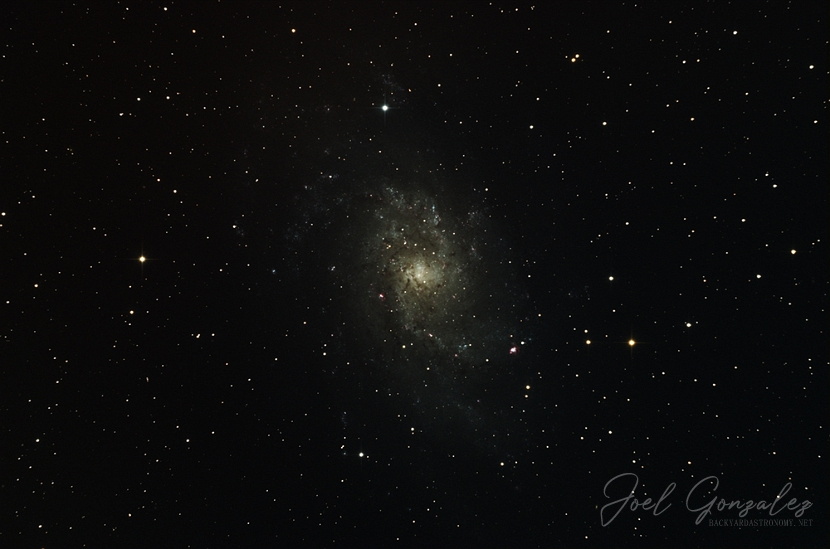 (106931) M33 10182014
(106931) M33 10182014
M33, the Triangulum galaxy. The Triangulum Galaxy is a spiral galaxy approximately 3 million light years (ly) from Earth in the constellation Triangulum. It is one of the most distant permanent objects that can be viewed with the naked eye. M33 is the third largest member in the local group after the Andromeda galaxy and the Milky Way. The local group consist of about 30 galaxies. 14x300sec fits exposures captured and combined in Nebulosity v3.2.0 software. Finishing touches done in PhotoShop. Telescope: Orion 8" 1000mm f4.9 Newtonian reflector. Mount: Orion Atlas EQ-G Guide Scope: Meade 800mm f10 reduced to f5 with Atik x.5 focal length reducer (ADM rings). Imaging Camera: Orion StarShoot Pro Color with Baader MPCC Mark III Coma Corrector Guide Camera: Meade DSI Pro monochrome 16bit camera. Imaging camera in prime focus. Filtration used: IR · Date/Time 2014:10:18 14:40:47 · Resolution 1000 x 662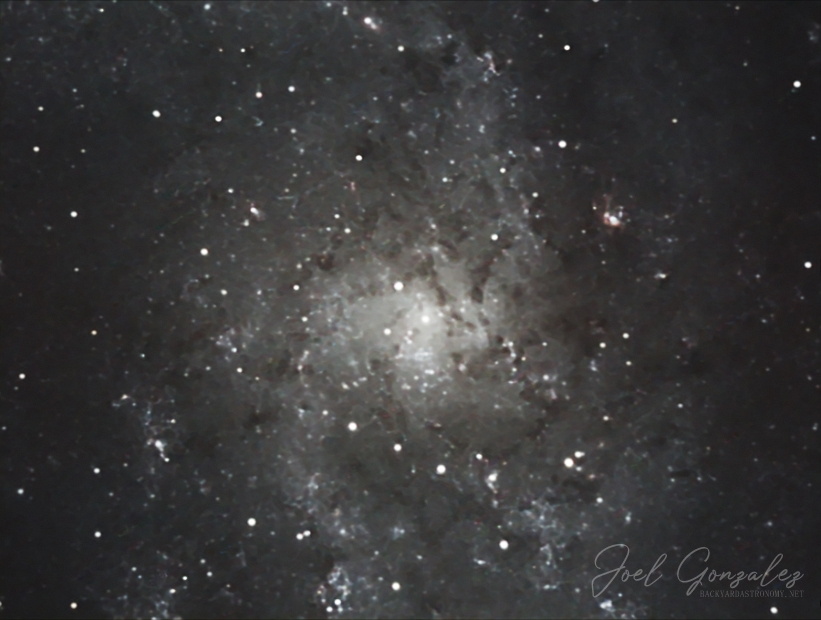 (103826) M33 12132011
(103826) M33 12132011
M33, the Triangulum galaxy. The Triangulum Galaxy is a spiral galaxy approximately 3 million light years (ly) from Earth in the constellation Triangulum. It is one of the most distant permanent objects that can be viewed with the naked eye. M33 is the third largest member in the local group after the Andromeda galaxy and the Milky Way. The local group consist of about 30 galaxies. 11x300sec fits exposures. Captured and combined in Nebulosity v2.4.0 software. Finishing touches done in PhotoShop. Telescope: Orion 8" 1000mm f4.9 Newtonian reflector. Mount: Orion Atlas EQ-G Guide Scope: Meade 800mm f10 reduced to f5 with Atik x.5 focal length reducer (ADM rings). Imaging Camera: Mead DSI Color 16bit camera with Peltier cooler modification. Guide Camera: Meade DSI Pro monochrome 16bit camera. Imaging camera in prime focus. Filtration used: Baader UV/IR Cut filter · Date/Time 2011:12:14 21:44:22 · Resolution 900 x 680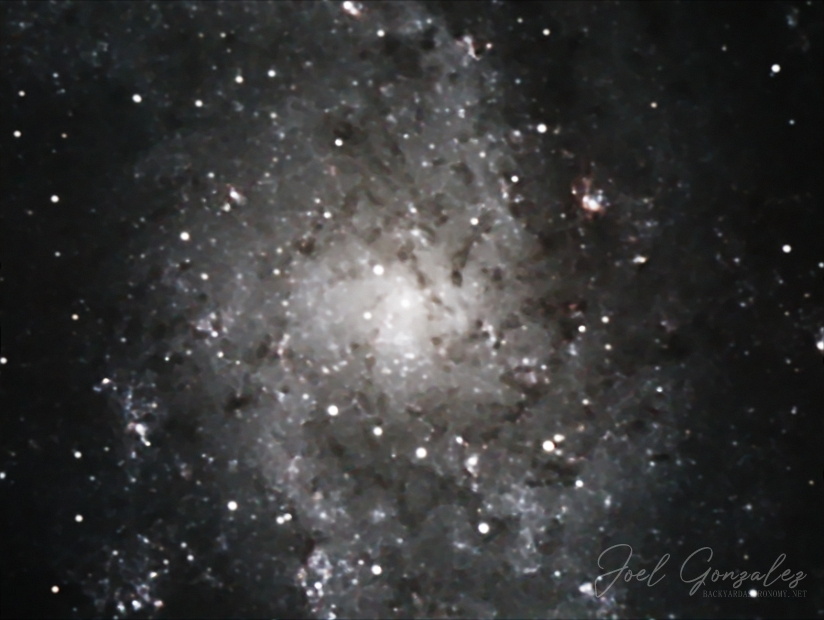 (76670) M33 07172012
(76670) M33 07172012
M33, the Triangulum galaxy. The Triangulum Galaxy is a spiral galaxy approximately 3 million light years (ly) from Earth in the constellation Triangulum. It is one of the most distant permanent objects that can be viewed with the naked eye. M33 is the third largest member in the local group after the Andromeda galaxy and the Milky Way. The local group consist of about 30 galaxies. 20x300sec fits exposures. Captured and combined in Nebulosity v2.4.0 software. Finishing touches done in PhotoShop. Telescope: Orion 8" 1000mm f4.9 Newtonian reflector. Mount: Orion Atlas EQ-G Guide Scope: Meade 800mm f10 reduced to f5 with Atik x.5 focal length reducer (ADM rings). Imaging Camera: Mead DSI Color 16bit camera with Peltier cooler modification. Guide Camera: Meade DSI Pro monochrome 16bit camera. Imaging camera in prime focus. Filtration used: Baader UV/IR Cut filter · Date/Time 2012:01:17 20:48:10 · Resolution 900 x 677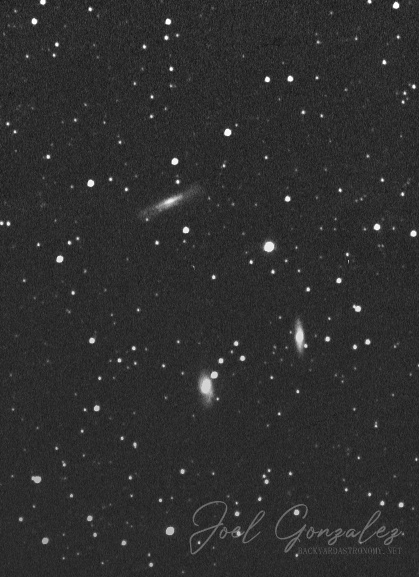 (73734) LeoTrip 15sec 50images 135mm
(73734) LeoTrip 15sec 50images 135mm
The famous Leo Triplett, M66, M65 and NGC3628. 50x15sec fits exposures captured and combined in Meade's Autostar Envisage V5.85 software. Histogram stretching, Curves, and Dynamic background extraction done in PixInsight LE 1.0. Finishing touches done in PhotoShop. Telescope: - Camera: Mead DSI Pro monochrome 16bit camera Peltier cooled. A 135mm 1:2.8 SLR lens was used for the wide angle shot. The camera was piggybacked on an Orion EQ1 motorized mount. Filtration used: Baader UV/IR Cut filter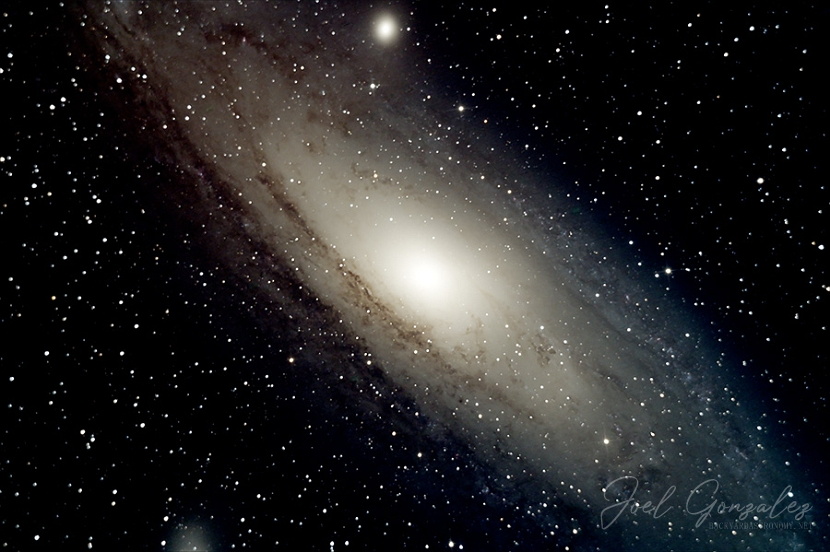 (68423) M31 10252013
(68423) M31 10252013
The Andromeda Galaxy is a spiral galaxy approximately 2.5 million light-years from Earth in the Andromeda constellation. 20x300sec fits exposures captured and combined in Nebulosity v3.1.0 software. Finishing touches done in PhotoShop. Telescope: Orion 8" 1000mm f4.9 Newtonian reflector. Mount: Orion Atlas EQ-G Guide Scope: Meade 800mm f10 reduced to f5 with Atik x.5 focal length reducer (ADM rings). Imaging Camera: Orion StarShoot Pro Color. Guide Camera: Meade DSI Pro monochrome 16bit camera. Imaging camera in prime focus. Filtration used: IR · Date/Time 2013:10:26 12:55:44 · Resolution 900 x 599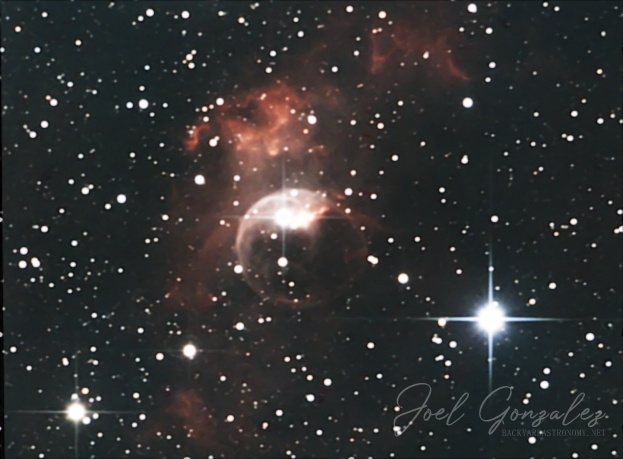 (68422) NGC7635
(68422) NGC7635
NGC7635, The Bubble Nebula, is a H II region emission nebula in the constellation Cassiopeia. This nebula is between 7,100 and 11,000 light-years from Earth and has an apparent magnitude of about 10. 29x300sec fits exposures captured in the span of two nights. Captured and combined in Nebulosity v2.4.0 software. Finishing touches done in PhotoShop. Telescope: Orion 8" 1000mm f4.9 Newtonian reflector. Mount: Orion Atlas EQ-G Guide Scope: Meade 800mm f10 reduced to f5 with Atik x.5 focal length reducer (ADM rings). Imaging Camera: Mead DSI Color 16bit camera with Peltier cooler modification. Guide Camera: Meade DSI Pro monochrome 16bit camera. Imaging camera in prime focus. Filtration used: Baader UV/IR Cut filter · Date/Time 2011:10:04 22:23:48 · Resolution 623 x 459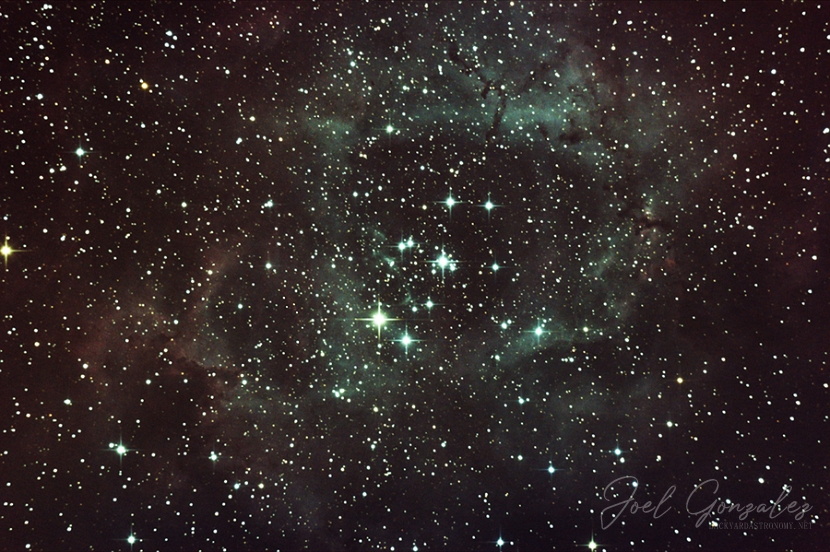 (63213) NGC2244 03162013
(63213) NGC2244 03162013
The Rosette Nebula (NGC2244) is a large, circular H II region located near one end of a giant molecular cloud in the Monoceros region of the Milky Way Galaxy. This nebula is 5,200ly from Earth. 5x600sec fits exposures captured and combined in Nebulosity v2.4.0 software. Finishing touches done in PhotoShop. Telescope: Orion 8" 1000mm f4.9 Newtonian reflector. Mount: Orion Atlas EQ-G Guide Scope: Meade 800mm f10 reduced to f5 with Atik x.5 focal length reducer (ADM rings). Imaging Camera: Canon Rebel T3i unmoded. Guide Camera: Meade DSI Pro monochrome 16bit camera. Imaging camera in prime focus. Filtration used: Baader UV/IR Cut filter · Date/Time 2013:03:20 22:37:12 · Resolution 900 x 599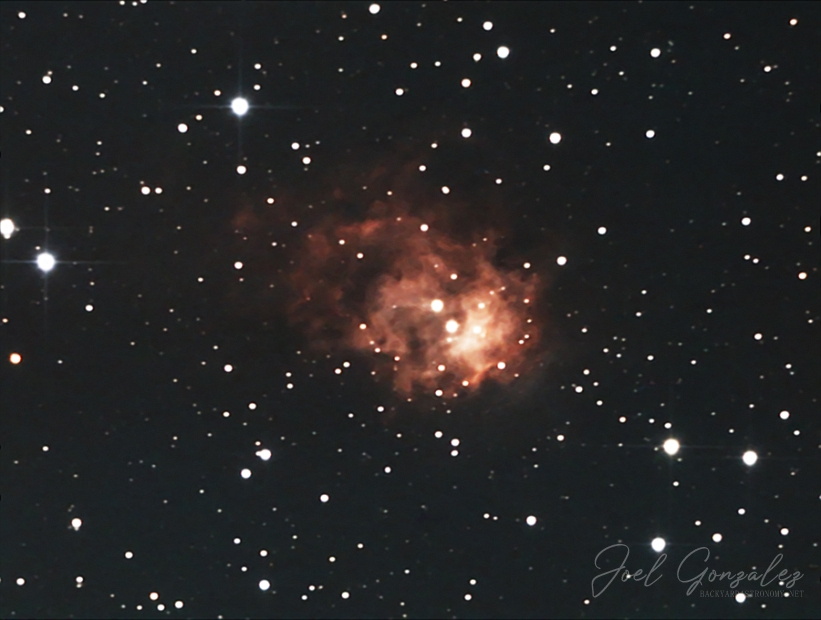 (62106) NGC7538 11292011
(62106) NGC7538 11292011
NGC 7538. Often overshadowed by the more famous Bubble Nebula which lies nearby, NGC 7538 is an exciting emission and reflection nebula located in Cepheus. While it is often overlooked by amateur astronomers, professionals looking to study stellar formation find it an exciting target as it is the host to ongoing star formation, including the largest known protostar. 16x300sec fits exposures. Captured and combined in Nebulosity v2.4.0 software. Finishing touches done in PhotoShop. Telescope: Orion 8" 1000mm f4.9 Newtonian reflector. Mount: Orion Atlas EQ-G Guide Scope: Meade 800mm f10 reduced to f5 with Atik x.5 focal length reducer (ADM rings). Imaging Camera: Mead DSI Color 16bit camera with Peltier cooler modification. Guide Camera: Meade DSI Pro monochrome 16bit camera. Imaging camera in prime focus. Filtration used: Baader UV/IR Cut filter · Date/Time 2011:11:30 22:40:40 · Resolution 900 x 680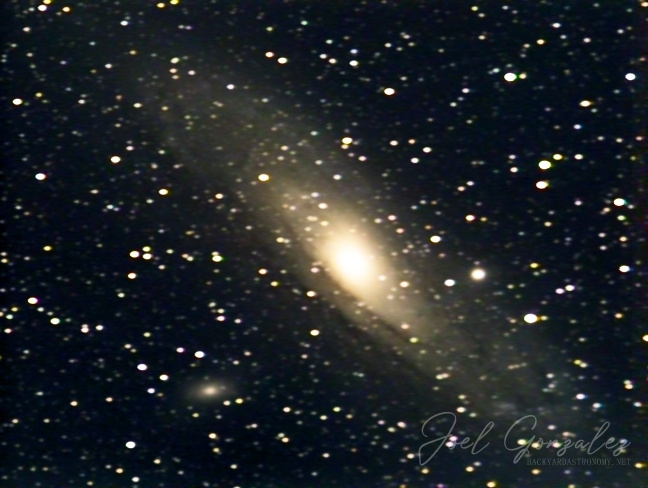 (61646) M31-30sec-LRGB-101507
(61646) M31-30sec-LRGB-101507
The Andromeda Galaxy M31. 30x30 second LRGB FIT. This image was my first DSI Color attempt. M32 and M110 are also visible here. Histogram, curves, and combining of LRGB channels done in PhotoShop. Telescope: - Camera: Meade DSI Color. 135mm 1:2.8 camera lens stopped down to 4 attached for wide field of view. Atop Orion EQ1 motorized mount. Filtration: Baader Planetarium UV/IR cut filter.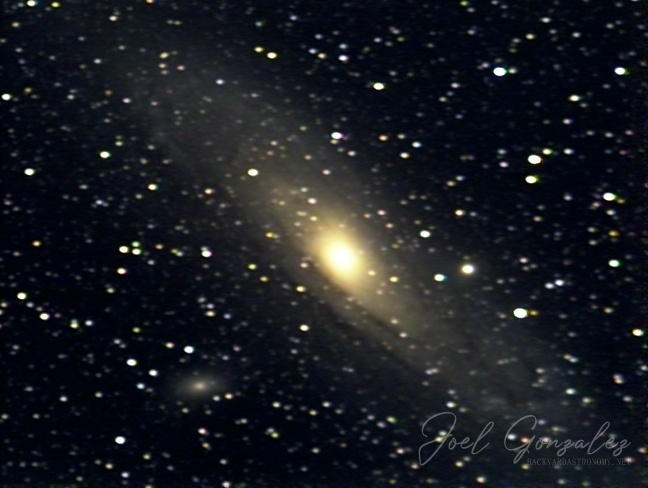 (59958) M31-60sec-Color
(59958) M31-60sec-Color
The Andromeda Galaxy M31. 60x17 second LRGB FIT. M32 and M110 are also visible here. Histogram, curves, and combining of LRGB channels done in PhotoShop. Telescope: - Camera: Meade DSI Color. 135mm 1:2.8 camera lens stopped down to 4 attached for wide field of view. Atop Orion EQ1 motorized mount. Filtration: Baader Planetarium UV/IR cut filter.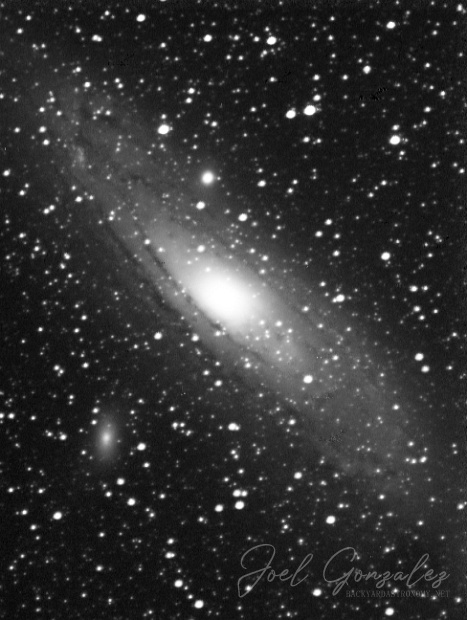 (58198) M31-30sec-101307
(58198) M31-30sec-101307
The Andromeda Galaxy M31. 30x30 second FIT. My first serious attempt at imaging this beautifull galaxy. M32 and M110 are also visible here. Not to much done to this image in the form of post processing. Histogram and curves done in PhotoShop, and High Pass Sharpening to get the dust lanes to be more visible also done in PhotoShop. That's about it. Telescope: - Camera: Meade DSI Pro. 135mm 1:2.8 camera lens stopped down to 4 attached for wide field of view. Atop Orion EQ1 motorized mount. Filtration: Baader Planetarium UV/IR cut filter.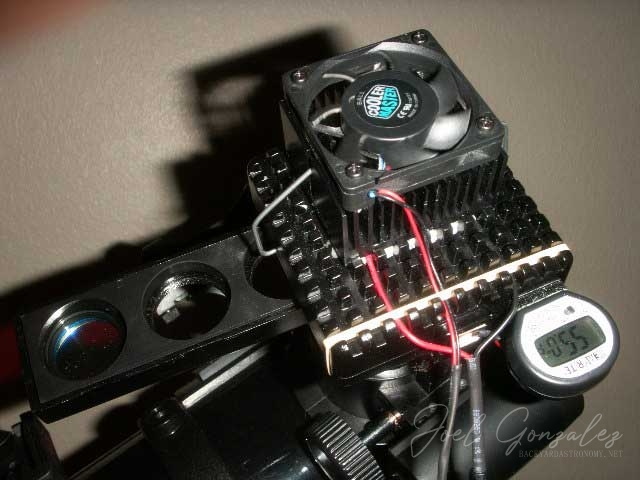 (56445) PeltierCooler DSI
(56445) PeltierCooler DSI
Here's an image of my primary astrophotography camera, the Meade DSI Pro with the Peltier cooler modification. I am very satisfied with the cooler mod as it has reduced a lot of the noise I was experiencing with the DSI Pro. I'm also very satisfied with how sensitive the DSI Pro is.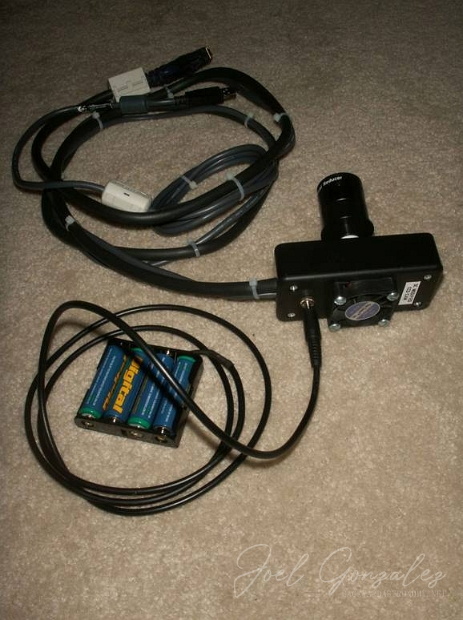 (55413) Modified Webcam
(55413) Modified Webcam
The final product after putting the webcam in a kit box, attaching the telescope adaptor, and adding a small cpu fan for suppressing some of the thermal noise in the images. The battery pack is for powering the fan.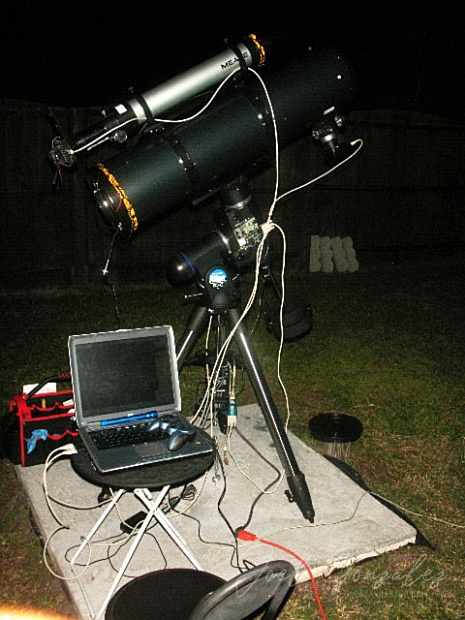 (52415) 8inch AtlasEQG Setup
(52415) 8inch AtlasEQG Setup
KONICA MINOLTA DIGITAL CAMERA · Original Date 3/14/11 10:32 AM · Model DiMAGE X1 · Focal Length (35mm) 37.0mm · Metering Mode Multi-segment · ISO Equivalent 160 · Exposure Time 1/40s · Aperture 3.5 · Exposure Bias Value 0 EV · Exposure Program Program normal · White Balance Auto white balance · Flash Flash fired, auto · Resolution 480 x 640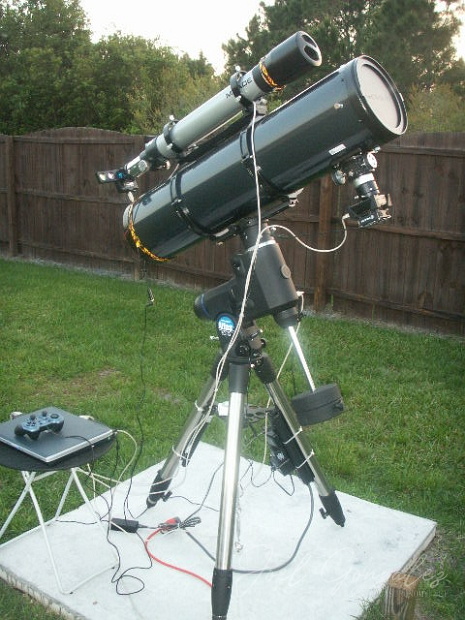 (51608) 8inch AtlasEQG Setup 02
(51608) 8inch AtlasEQG Setup 02
Here is a photo of my new astrophotography setup. The mount is an Orion Atlas EQ-G. The main telescope is an Orion 8" 1000mm f4.9 reflector, and the guide scope is a Meade 80mm refractor. · Original Date 4/12/11 7:58 AM · Model DiMAGE X1 · Focal Length (35mm) 37.0mm · Metering Mode Multi-segment · ISO Equivalent 160 · Exposure Time 1/40s · Aperture 3.5 · Exposure Bias Value 0 EV · Exposure Program Program normal · White Balance Auto white balance · Flash Flash fired, auto · Resolution 480 x 640